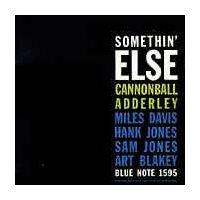Classic nails the reissue of this 1958 original
While this much-loved Blue Note lists Adderley as the group leader, this pick-up session--recorded in 1958, just before Kind of Blue--sounds, for the most part, as if Miles Davis is in control: or at least that his sensibilities at the time had deeply influenced Adderley\\'s musical thinking.While this much-loved Blue Note lists Adderley as the group leader, this pick-up session--recorded in 1958, just before Kind of Blue--sounds, for the most part, as if Miles Davis is in control: or at least that his sensibilities at the time had deeply influenced Adderley's musical thinking. With Hank Jones on piano and the rhythm section of Sam Jones and Art Blakey, whoever is in charge leads the group through a set of three standards ("Autumn Leaves," "Love For Sale," and "Dancing in the Dark") and two originals (Nat Adderley's funky "One For Daddy-O" and Davis' own "Somethin' Else").
As an introduction to jazz, Somethin' Else can't be beat. With the group reinventing three well-known, tuneful classics, neophytes can come to grips with improvisations on a familiar theme, on group interplay, and on the basics of what jazz is--or at least was, in 1958. Of course, this easy-to-digest set holds pleasures for experienced jazz enthusiasts as well.
The opener, "Autumn Leaves," is stretched out and taken at a languid pace, allowing for some juicy solos from both Davis and Adderley, the latter of whom was but 30 at the time and had joined up with Davis only the year before. After a brooding piano intro by Jones tethered to the rhythm section's vamp, and an opening flourish by a raucous plunger mute, Davis's statement of the melody is characteristically spare and stately, and uncharacteristically straight on the melody. When he hands it off to Cannonball, the Charlie Parker-schooled alto saxophonist sets off sparks. There's a nice piano interlude, then Davis restates the melody. The track ends as it had started, with Jones' slinky piano lines playing around the melody while the rhythm section restates the opening theme.
No point in doing a detailed play-by-play of all five tracks: Leonard Feather does that on the liner notes (typical of the times) complete with chords. Just listen out for Miles' playful "Is that what you wanted, Alfred?" (referring to the uncredited producer, Alfred Lion) at the end of "One for Daddy-O." I heard the album for the first time on headphones back in 1964 and I almost had a heart attack--I thought someone had broken into the apartment.
This is not a milestone recording or an essential for any jazz collection, but it is one of the most easy-to-love jazz albums I have in my collection and I've been playing it for almost 40 (gasp!) years and I still enjoy listening, so it was certainly money well spent ($5.98 at Masters, Lake Success, NY).
Classic has done an absolutely superb job with this reissue, making it available in both mono and stereo editions. I compared the stereo to my original Blue Note and to a number of reissues that have come out over the years: one on Blue Note/Liberty but with the RVG mastering stamp on it, one on a solid-blue label non-RVG, a Capitol-mastered reissue of a few years ago, and Classic's recent 180-gram reissue. I also compared the mono version to a Japanese Toshiba-EMI from a decade or so ago.
Look: while some have been critical of some of Classic's classical reissues, Bernie Grundman is a jazz fanatic who acquired his cutting chops doing jazz titles. I think these 200-gram Quiex SV-P reissues sound superb by any standard. They are not bright or edgy, nor are they rolled-off and warm sounding--and nor is my original, though it's been played probably 100 or more times. I think that with these latest Blue Note jazz titles, Classic and Grundman have gotten to the essence of what's on the tapes and what Rudy Van Gelder intended them to sound like. The original is a bit "bigger" sounding and somewhat airier, but the differences are neither epic nor critical.
This is a typical Van Gelder recording of the time: multi-miked, live-to-two-track, and meant to be mixed down to mono. While Sam Jones' piano (a typically boxy Van Gelder piano sound of the time) has been placed just to the left of center, the Blakey/Hank Jones rhythm section is hard right, while Adderley/Davis are hard left. A mix like this is not what is meant by "stereo," and while Van Gelder's addition of a dollop of reverb to make the sound gel does expand the image sizes somewhat (as well as adding some space and vividness), compared to the impeccable mono edition, I just don't think it holds up nearly as well.
The mono edition's impeccable front-to-back layering of the instruments puts each in its appropriate place (Davis and Adderley up front, Jones' piano well back, the rhythm section further back), producing a sonic portrait of a group endeavor--not dueling pairs of musicians playing from across a great divide.
If the idea of mono is simply abhorrent to you, don't let me stop you: go for the stereo. In either format this is a winning disc sure to provide you with years of listening pleasure. Mention must be made of Classic's attention to detail: the 200-gram flat pressing (no "groove guard" lip), "deep groove" label, the paper on cardboard jackets, the Blue Note catalog inner sleeves, and even the gold "stereo" sticker label: just like the original. However, if you already have the Classic 180-gram stereo edition, it's probably not worth upgrading to get the "deep groove" label, flat pressing, and deluxe jacket, though the sound is marginally richer.
For digital-only folks, there's also an RVG-remastered CD which is "stereo" but cuts way back on the separation, and Classic probably still has its DAD DVD-Video-based disc available, mastered with the original wide separation mix. Naturally, the vinyl sounds best.



